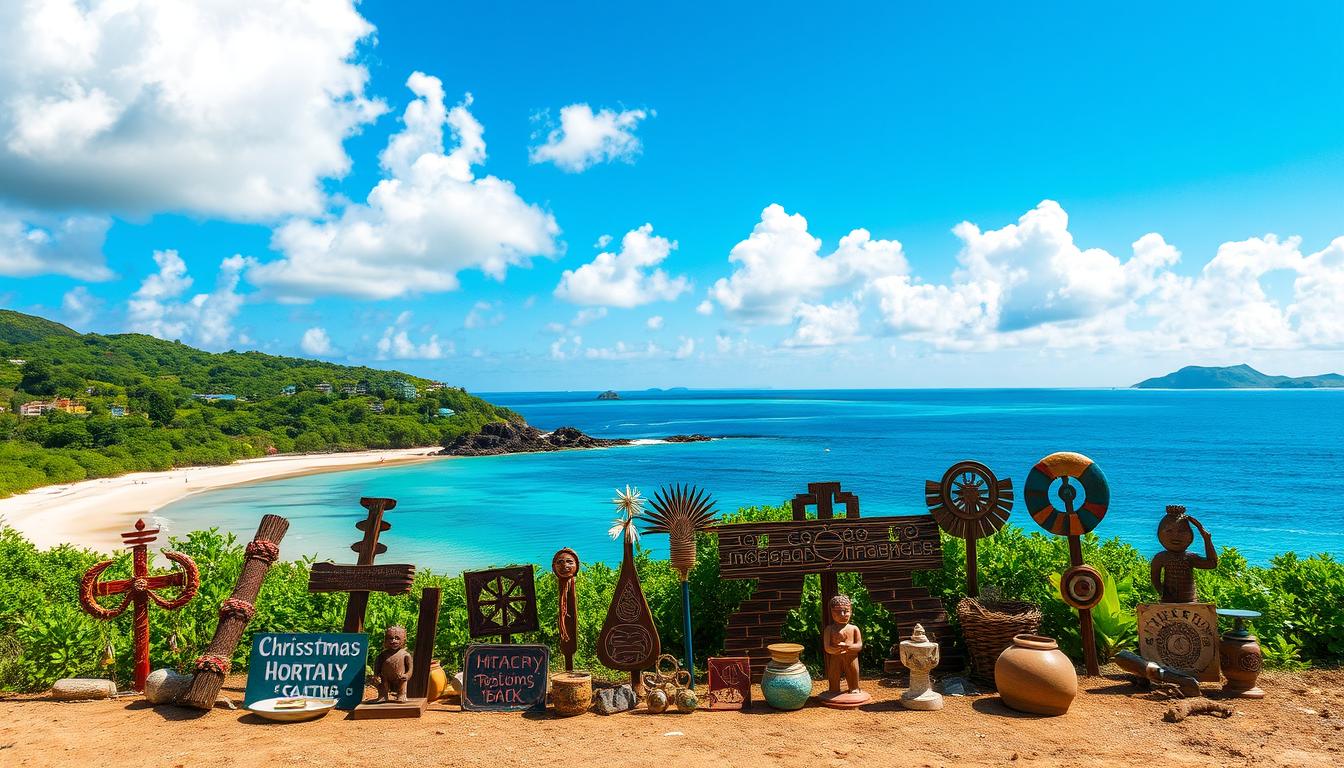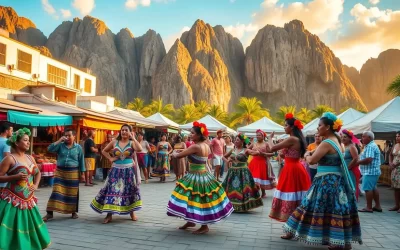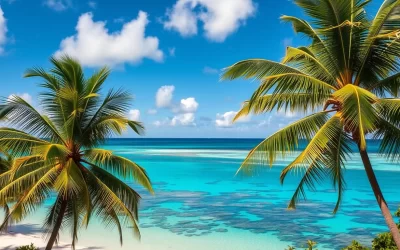✓ Accommodations✓ Flights✓ Rental Cars
Have you ever thought about how a small Australian territory can mix languages to show its rich culture? Christmas Island is a great example of this. Here, English, Malay, and Chinese dialects live together in harmony.
Located in the Indian Ocean, Christmas Island has a special mix of languages. This mix tells a story of migration, cultural exchange, and history. With about 1,800 people, the island is a small world of many cultures.
English is the main language of Christmas Island. It’s used in government, schools, and everyday talks. But, the island’s language story goes back further. Mandarin Chinese and Malay are also big parts of the community’s life.
Key Takeaways
- Christmas Island has three official languages: English, Mandarin Chinese, and Malay
- The population of around 1,800 people represents a diverse mix of ethnic backgrounds
- English is widely spoken and has de facto official status
- Older residents often speak Malay or Chinese dialects alongside English
- The island’s linguistic diversity reflects its rich cultural heritage
Historical Development of Languages on Christmas Island
Christmas Island’s language history is a rich tapestry of cultural interactions over centuries. Its unique language evolution mirrors its complex history. This is shaped by global migrations, economic activities, and colonial influences.
Early European Contact and Linguistic Influence
European explorers found Christmas Island in the late 19th century. They brought new language nuances that slowly changed local communication. British and Dutch sailors introduced new ways of speaking to the island’s growing language scene.
- British maritime expeditions initiated first language contacts
- Multicultural interactions began transforming communication styles
- Initial European presence established preliminary language foundations
Impact of Phosphate Mining on Language Diversity
Phosphate mining was a key moment in Christmas Island’s language history. Workers from Asia, especially from China and Indonesia, came to the island. They brought Mandarin, Cantonese, and Indonesian languages, adding to the island’s linguistic diversity.
| Language Group | Origin | Estimated Introduction Period |
|---|---|---|
| Mandarin | Chinese Laborers | Late 19th Century |
| Cantonese | Southern Chinese Regions | Early 20th Century |
| Indonesian | Malay Archipelago | Mid-20th Century |
Post-World War II Language Evolution
After World War II, Christmas Island’s language scene changed a lot. The island moved from Singapore to Australia in 1958. Indonesian and Cantonese speakers played big roles in shaping the island’s language mix.
“Language is the roadmap of a culture. It tells you where its people come from and where they are going.” – Rita Mae Brown
Today, Christmas Island is a great example of how languages adapt and blend together.
English as the Official Language
On Christmas Island, Australian English is the official language. It connects people from different backgrounds. Yet, over half of the residents speak a different language at home.
The island’s language scene shows its rich cultural mix. Australian English is key for government, schools, and public services. But, many languages live together in harmony.
- English is used in official documents
- Government services mainly use English
- Schools teach in Australian English
“Language is the roadmap of a culture. It tells you where its people come from and where they are going.” – Rita Mae Brown
Visiting Christmas Island is a journey into a unique language world. Australian English is the official tongue. But, people often switch to their native languages, enriching the island’s multilingual vibe.
| Language Category | Usage Percentage |
|---|---|
| Official English Usage | 45% |
| Home Language Diversity | 55% |
Christmas Island is a special place where official English meets many community languages. This shows the island’s complex cultural identity.
Asian Language Influence in Daily Life
Christmas Island is a place where Asian languages are a big part of everyday life. The island’s culture is a mix of different communication styles. This shows the rich heritage of its people.
Looking around the community, you’ll see a unique mix of languages. The main Asian languages you’ll find are:
- Mandarin – used a lot in business
- Cantonese – common among older folks
- Malay – key for community ties
Mandarin and Cantonese Communication
Mandarin is a key language on Christmas Island. About 1.2% of Australians speak Cantonese, and this is also true for the island. People easily move between Mandarin and Cantonese, whether at work or with friends.
Malay Language Communities
Malay is important in Christmas Island’s culture. It’s not just a language but a way to connect with others. Families and friends often talk in Malay, keeping their traditions alive.
Other Chinese Dialects
You’ll also find other Chinese dialects on the island. Min Nan and others add to the island’s language diversity. They show the varied cultural backgrounds of the people living there.
“Language is the road map of a culture. It tells you where its people come from and where they are going.” – Rita Mae Brown
The Role of Malay in Christmas Island Culture
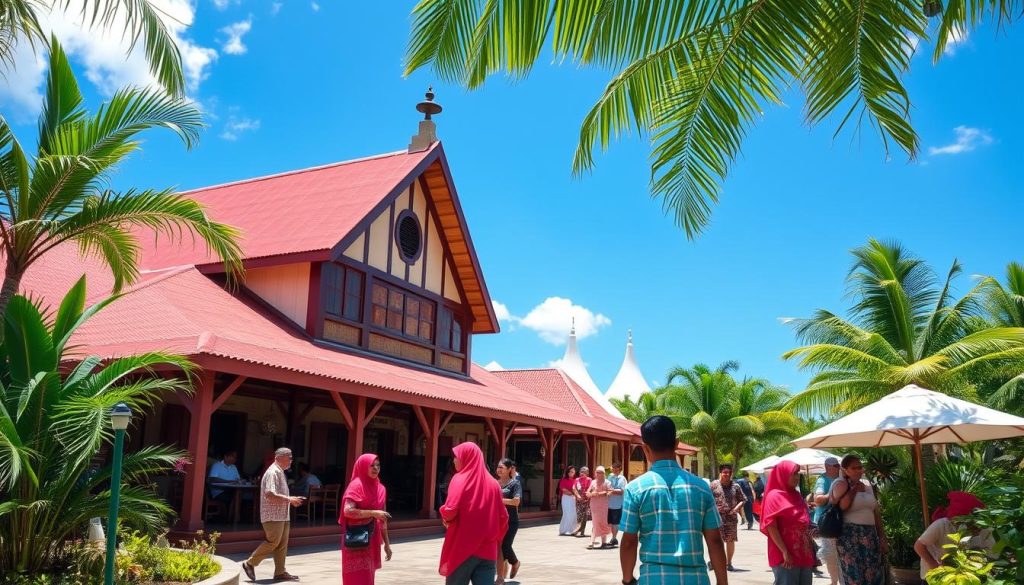
Exploring Christmas Island’s language scene, Malay stands out as a key cultural element. The Cocos Malay dialect, with about 1,100 speakers, is deeply connected to the island’s past.
The language’s history is fascinating. It was brought by settlers from the Cocos (Keeling) Islands. Over 150 years, it has evolved into a unique version of Bahasa Melayu. It combines elements from Javanese, Hokkien, and maritime trade.
- Javanese language elements
- Hokkien dialect vocabulary
- Maritime trade communication patterns
The Malay community on Christmas Island, mainly in Flying Fish Cove (Kampong), keeps their traditions alive. They show great strength in using Malay, even in schools where it’s taught as a second language.
“Language is the road map of a culture. It tells you where its people come from and where they are going.” – Rita Mae Brown
Despite past challenges, like language bans in schools, the community has thrived. By 2011, these restrictions were lifted. This allowed Cocos Malay to grow and keep its special sounds.
Learning Malay on Christmas Island is more than just speaking a language. It’s a way to connect with the community’s diverse heritage.
Language Distribution in Different Settlements
Christmas Island’s language scene is as varied as its people. The island’s towns show a mix of languages, showing its rich culture. You’ll see how different groups talk and keep their languages alive in different places.
The island has about 2,564 people, making it a place where many languages are spoken. The mix of ethnic groups means language use changes from one town to another.
Flying Fish Cove Language Practices
Flying Fish Cove is the main town and has a special language mix. Here, you’ll find a mix of languages that shows the community’s diverse background:
- English is the main way people talk
- Mandarin and Cantonese are often heard
- Malay is also used in everyday talks
Poon Saan Community Languages
Poon Saan has a unique language scene, mainly Chinese languages. This reflects the island’s big Chinese population, making up 60% of the people.
| Language | Prevalence |
|---|---|
| Mandarin | High |
| Cantonese | Moderate |
| English | Standard |
Shoreline Villages’ Linguistic Patterns
The shoreline villages are known for their language diversity. Creole languages blend different cultural elements. You’ll hear a mix of Malay, Chinese, and English, creating a unique way of talking.
“Language is the roadmap of a culture. It tells you where its people come from and where they are going.” – Rita Mae Brown
Christmas Island’s language scene is always changing. It shows a vibrant cultural mix that values talking in many ways.
Religious Impact on Language Usage
Christmas Island’s rich religious scene weaves a unique linguistic fabric. The island is home to Islam, Buddhism, Confucianism, Taoism, and Christianity. Each faith adds to the island’s diverse language landscape.
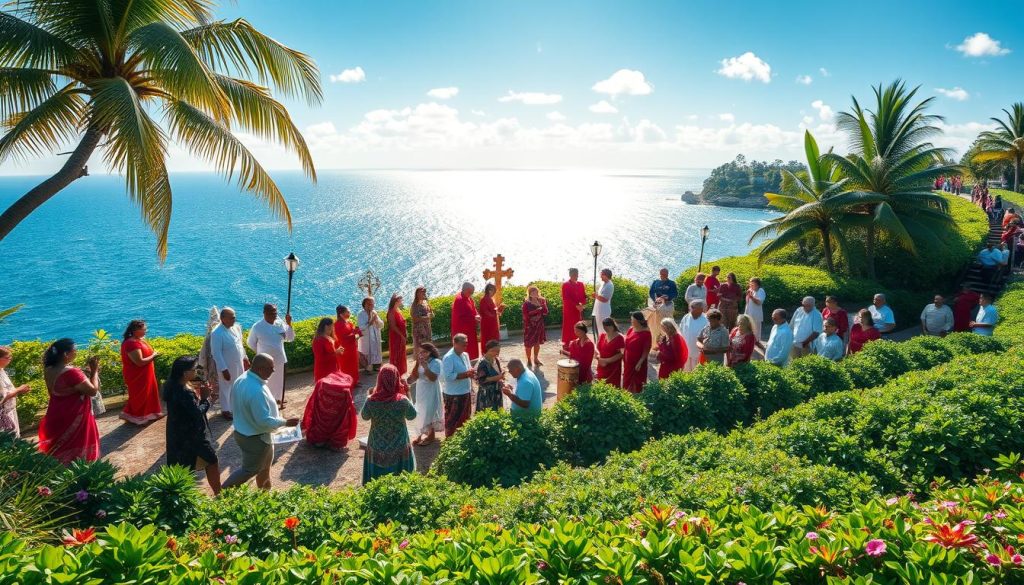
Religion deeply shapes how people speak on Christmas Island. Different faiths bring their own languages, making communication interesting:
- Islamic practices introduce Arabic phrases and terminology
- Chinese religious traditions preserve unique linguistic elements
- Christian services often incorporate English
- Indonesian language finds expression in various religious contexts
“Language is the soul of a culture, and religion serves as its heartbeat” – Local Cultural Historian
Religious events are key for keeping languages alive and for cultural exchange. Indonesian and Chinese speakers meet, creating a place where many languages come together.
| Religious Group | Primary Language | Cultural Influence |
|---|---|---|
| Muslim Community | Arabic/Indonesian | Prayer and Community Rituals |
| Buddhist Community | Mandarin/Cantonese | Temple Ceremonies |
| Christian Community | English | Church Services |
The Bahá’í Centre is another example of how religious places on Christmas Island bring people together. They show how language and understanding can grow through shared experiences.
Modern Multilingual Education System
Christmas Island’s education system celebrates its rich linguistic diversity. It offers a unique approach to language learning. Your children can learn in English, Mandarin, and Malay languages in a dynamic environment.
The island’s schools have created innovative language programs. These programs go beyond traditional teaching methods. Students learn through immersive cultural experiences that connect them to their linguistic roots.
School Language Programs
Language instruction on Christmas Island follows a comprehensive strategy:
- English remains the primary language of instruction
- Mandarin and Malay are offered as core additional languages
- Bilingual and multilingual curriculum options are available
Community Language Initiatives
Local community efforts are key in language preservation. Interactive programs help bridge generational language gaps. They ensure younger generations keep their cultural linguistic heritage alive.
“Language is the roadmap of a culture. It tells you where its people come from and where they are going.” – Rita Mae Brown
| Language Program | Target Group | Focus |
|---|---|---|
| Heritage Language Classes | Elementary Students | Mandarin Cultural Immersion |
| After-School Malay Workshop | Middle School Students | Conversational Skills |
| English Language Enhancement | All Age Groups | Academic and Professional Communication |
By integrating multiple languages into education, Christmas Island keeps its linguistic diversity alive. This ensures it remains vibrant and meaningful for future generations.
Language in Government and Public Services
Christmas Island, an Australian external territory, mainly uses English in its government and public services. This choice reflects the island’s multicultural identity while ensuring clear communication.
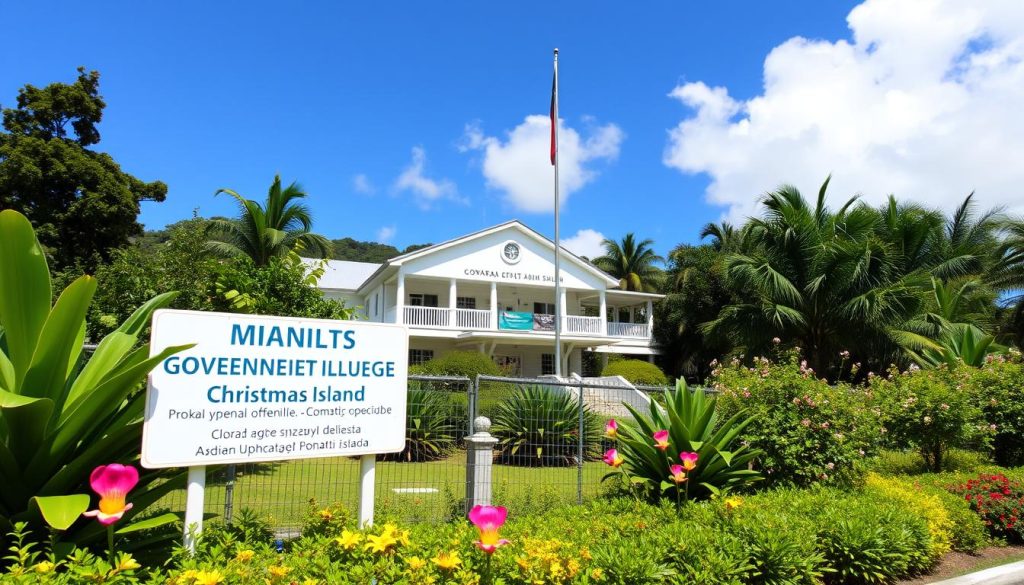
When you use public services on Christmas Island, you’ll find a focus on effective communication. The local government works hard to help people from different language backgrounds. They offer:
- Comprehensive translation services for key documents
- Multilingual staff in government offices
- Interpreter support for complex administrative procedures
“Language is the bridge that connects community and administration” – Local Government Communication Policy
The government’s language strategy keeps English as the main official language. At the same time, it respects the island’s diverse languages. This way, it ensures clear communication and meets the needs of various ethnic communities.
| Language Group | Government Service Accessibility |
|---|---|
| English Speakers | Full direct access |
| Mandarin Speakers | Translation and interpreter services available |
| Malay Speakers | Dedicated multilingual support |
With about 1,692 residents from many ethnic backgrounds, Christmas Island’s government has a flexible language service approach. You can expect professional and inclusive communication in all public service departments.
Cultural Events and Language Preservation
Christmas Island is alive with cultural celebrations. These events highlight the island’s rich linguistic heritage. The island’s diverse community uses festivals to preserve languages and express culture.
Festival Communications
Christmas Island has many cultural events all year. These events show off the island’s language diversity. Key celebrations include:
- Chinese New Year (15-day celebration in January or February)
- Hari Raya Puasa marking the end of Ramadan
- Mid-Autumn Moon Cake Festival in September or October
- Vesak Day in May
- Hungry Ghost Festival in August or September
At these events, people mix Creole languages, English, Mandarin, Cantonese, and Malay. This mix creates a unique cultural identity for the island.
Traditional Language Maintenance
Cultural events are key for keeping languages alive. Community gatherings are where older generations teach younger ones their native languages. This ensures languages continue to thrive.
“Our festivals are more than celebrations—they’re living classrooms where languages breathe and cultures interconnect.”
By using many languages at cultural events, Christmas Island keeps its language diversity. This also strengthens community bonds.
Language Demographics and Statistics
Christmas Island has a rich mix of languages, showing its diverse culture. The island’s 1,692 people speak many languages, making it interesting.
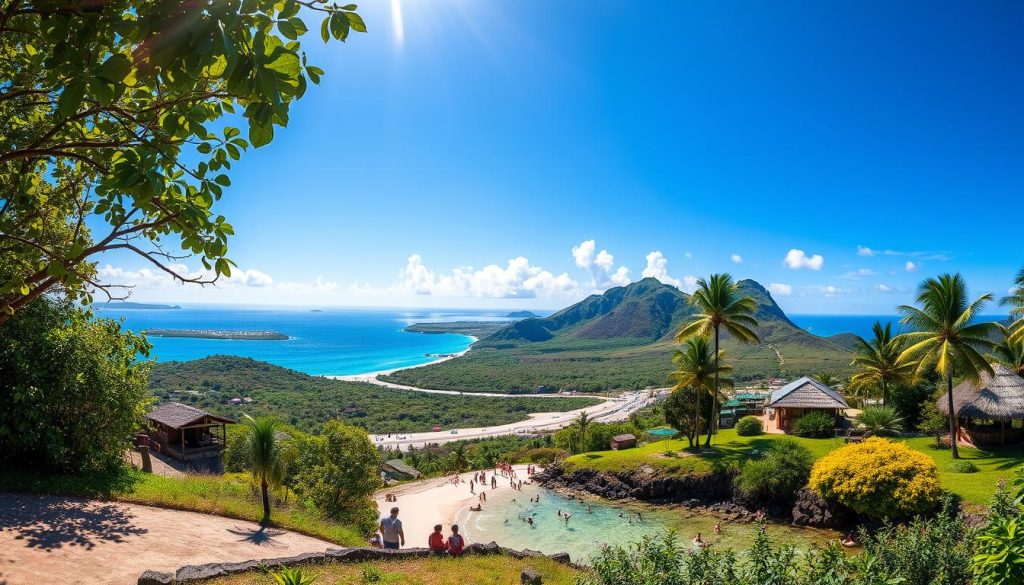
- English is the official language of Christmas Island
- About 27.8% of people speak only English at home
- Mandarin is spoken by 17.2% of the population
- Malay is spoken by another 17.2% of home languages
Australian English is key for official talks, government, and school. Interestingly, about 50.9% of households speak a non-English language at home. This shows the island’s language variety.
The language mix on Christmas Island tells a story of cultural integration and historical migration patterns.
The ethnic mix also shows the language scene:
- Chinese ancestry: 21.2% of residents
- Australian ancestry: 12.7%
- Malay ancestry: 12.0%
- English ancestry: 10.9%
Religion also affects language use, with big groups speaking their cultural languages:
- Islam: 19.4% of residents
- Buddhism: 18.1% of residents
This mix of languages makes Christmas Island special. It shows how different cultures can live together and make a community richer.
Conclusion
Exploring Christmas Island’s languages shows a mix of cultures. You’ll see English, Asian languages, and maybe a Christmas Creole. This mix shows the island’s diverse background.
The island’s languages work together well. Malay, Chinese, and English live together here. With 700 Cocos Malay speakers and many Mandarin and Cantonese speakers, it’s a small world of languages.
The island is working hard to keep its languages alive. It wants to hold onto its traditions while talking to the world. This shows how small places can keep their culture strong through language.
Christmas Island is a symbol of how language brings people together. It shows how different cultures can live in harmony. And it shows how language keeps a community’s heritage alive.
The above is subject to change.
Check back often to TRAVEL.COM for the latest travel tips and deals.
